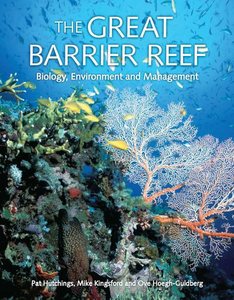Coral reef habitats and assemblages
Syms, C., and Kingsford, M.J. (2008) Coral reef habitats and assemblages. In: Hutchings, Pat, Kingsford, Mike, and Hoegh-Guldberg, Ove, (eds.) The Great Barrier Reef: biology, environment and management. CSIRO Publishing, Collingwood, VIC, Australia, pp. 40-50.
![[img]](https://researchonline.jcu.edu.au/7464/2.hassmallThumbnailVersion/7464_Syms_and_Kingsford_2008_cover.jpg)
|
Image (JPEG) (Book Cover)
- Cover Image
Download (150kB) |
|
|
PDF (Published Version)
- Published Version
Restricted to Repository staff only |
Abstract
Coral reefs often characterise the immediate subtidal environment in tropical regions. The definition of a coral reef is a loose one. In one sense, it is simply a hard substratum that supports corals. Many geologists, however, restrict the term to large subtidal hard bottoms ('reefs') in which the hard base (that may be 1-2 km thick on some reefs) consists mostly of dead corals, generated by the death and assimilation of the carbonates fixed by coral polyps into the hard substratum, usually beneath a living veneer of live corals. This process is unique to reef-building or hermatypic corals, which contain symbiotic algae or zooxanthellae, and typically occur in tropical regions in which the average winter water temperature is greater than 18C. However, corals themselves, and the organisms associated with them, are not constrained to reefs generated in this way. On the Great Barrier Reef (GBR) corals occur both on carbonate reefs, as geologists define coral reefs, and on geologically formed rock bases such as granite. These rock bases occur on the mainland and on islands in the centre of the GBR itself. In these areas corals simply form a structural veneer, contributing physical and biological structure to the underlying hard rock. On volcanic-origin islands, particularly in the south (to about 30S), scleractinian corals may also be found mixed with tufting and laminarian algae (groups more characteristic of temperate reefs). The organisms that occupy carbonate and non-carbonate reefs arc the same, and interact with the reef and other organisms in the same way, consequently we include both carbonate and non-carbonate reefs under the broad umbrella of 'coral reefs'. This imprecise definition is unfortunate, but necessary. Geologists have a clear definition of a 'coral reef' as a geomorphological structure built by corals. It can also be argued that the structural veneer - the coral communities themselves - are the central component of coral reefs. However, not all organisms on a coral reef are positively associated with corals. A reef community is more than its physiographic origin and dominant space-occupiers. A key to the diversity of a coral reef lies in its habitat heterogeneity, which of course includes areas that are not occupied by corals themselves.
| Item ID: | 7464 |
|---|---|
| Item Type: | Book Chapter (Research - B1) |
| ISBN: | 978-0-643-09557-1 |
| Keywords: | Great Barrier Reef; coral reefs; spatial variability; temporal change; crown of thorns starfish; marine sciences |
| Date Deposited: | 23 Dec 2009 23:34 |
| FoR Codes: | 05 ENVIRONMENTAL SCIENCES > 0502 Environmental Science and Management > 050202 Conservation and Biodiversity @ 100% |
| SEO Codes: | 96 ENVIRONMENT > 9605 Ecosystem Assessment and Management > 960507 Ecosystem Assessment and Management of Marine Environments @ 100% |
| Downloads: |
Total: 321 Last 12 Months: 7 |
| More Statistics |



